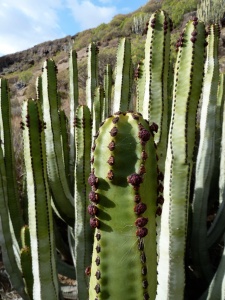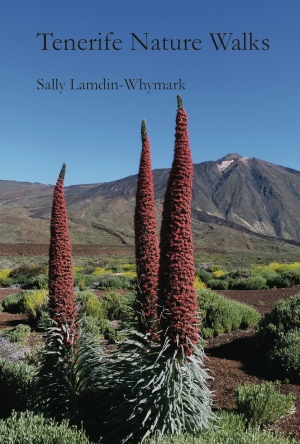Blog Archives
A walk from Tajao on the south coast of Tenerife
Posted by Sally Whymark

Rocks in the barranco near the beginning of the walk showing the varied geology. The grass plant in front of the boulder is the very invasive introduced plant, Pennisetum setaceum.
I did this walk with a group of friends two weeks ago on the 2nd April. We decided to do a walk near the coast as the weather was a bit uncertain, and there were black clouds up the hills. So we thought we would explore the area inland from Tajao, as we had not walked there before. By walking near the coast we managed to avoid rain except for a few tiny drops at our highest point, and we saw an abundance of flowers, some endemic, others native and many ruderals and introduced species mainly from Europe.
I haven’t posted about this walk before as we saw so many flowers that I still have not identified all of them in the few spare minutes that I have had. However, I thought I had got names for enough of them to make a post now, to share with interested friends.

Canary Volutaria (Volutaria canariensis) A widespread annual growing to about 2 ft / 60cm high. It is a Canary endemic
I am not going to describe the walk as it was not the most inspiring walk I’ve done, and am not likely to do it again myself, since it passed through a quarry, where the track we were on disappeared, then having gained another track on a ridge we looked across at what turned out to be a landfill site! Further on we passed a solar farm, and an intensive animal farm with modern sheds and silos, though we could not see what animals it housed. So it was not the most scenic walk I have done in Tenerife, but it did have its moments, and it also passed through several areas of natural basal zone vegetation which were interesting.

Canary rock rose (Helianthemum canariense) is a canary endemic which likes open rocky sites in the basal zone.
We were following a track we had downloaded from Wikiloc contributed by the user “Rutas de Tenerife” which you will find at the following link: http://www.wikiloc.com/wikiloc/view.do?id=4025346
However, be warned. We lost our way in the quarry where recent work appeared to have destroyed the path we were following, and we also lost our way halfway down the descent, in an area of loose rocks which was difficult to walk on without a path.
The plants that are illustrated are relatively common near the coast in the south of the island, so I hope it will interest you on walks in the south even though this walk was not the most recommended!

Volutaria tubuliflora is an annual which is a more widespread (non endemic) species of Volutaria. They are related to the knapweeds.

A typical view of the vegetation in the rocky part of the descent, with a Mataperros, (Ceropegia fusca) in the foreground (grey stick-like), Balo (Plocama pendula) the drooping shrub behind, Bitter spurge (Euphorbia lamarckii) the yellowing bush to its right, and Cardón (Euphorbia canariensis) the candlesticks behind.
Posted in Botanical interest, South Tenerife, Walks in Tenerife
Tags: Ajuga iva, Bartsia latifolia, Canary rock-rose, Canary spurge, Cardon, Ceropegia fusca, Euphorbia canariensis, Fagonia albiflora, Frankenia capitata, Helianthemum canariense, hiking, Lotus sessilifolius, nature, Pennisetum setaceum, Polycarpaea nivea, Reseda scoparia, senderismo, Senecio glaucus ssp coronopifolius, Tajao, Tenerife, Volutaria canariensis, Volutaria tubuliflora, walking










